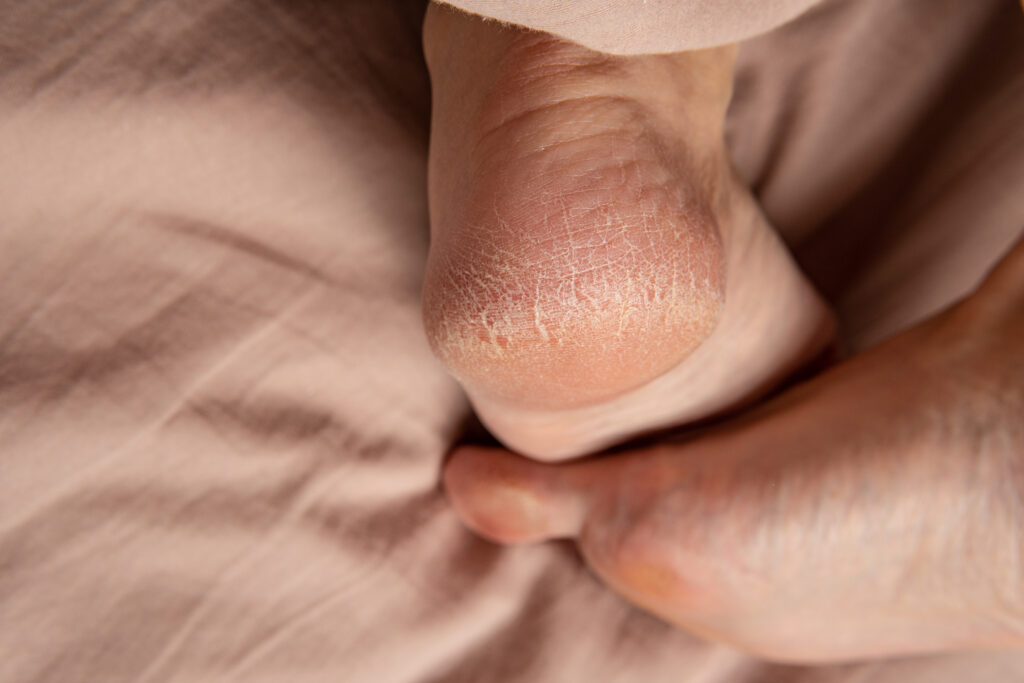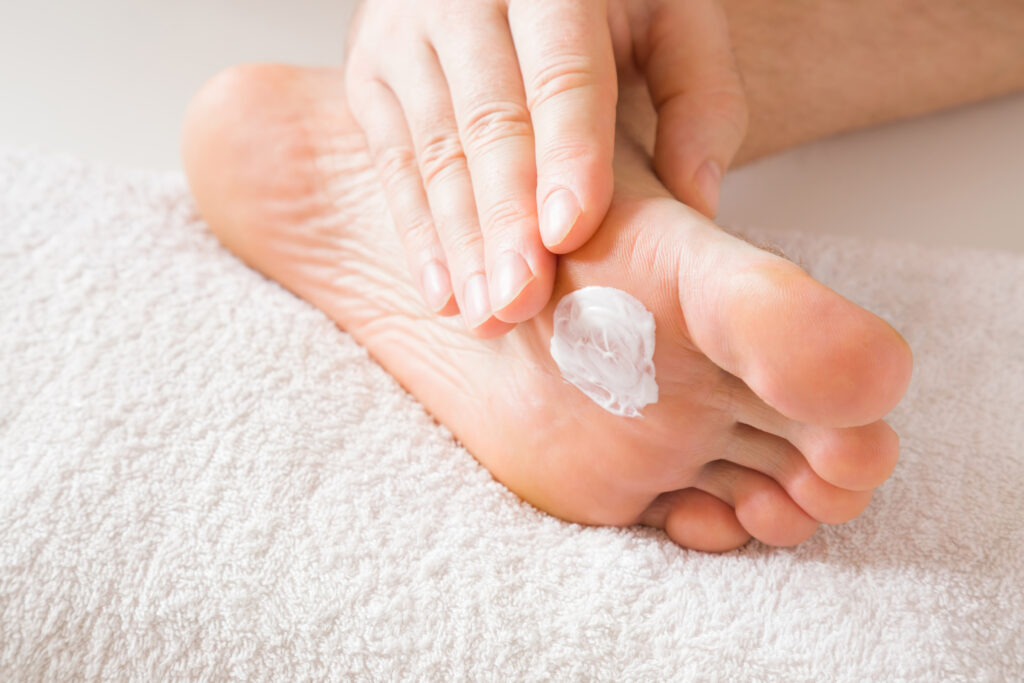Cracked Feet and Heels
Cracked feet is a foot condition that causes dry, thick skin – often around the heels of the foot (called heel fissures). It is caused by a build-up of thick dead skin on feet that eventually cracks and becomes painful.
For many people with cracked feet, it is a cosmetic issue, but it can also become a medical problem if it leads to painful cracked heels and even infection. Fungal infections like athlete’s foot are common in people with dry, cracked feet.
Fortunately, there are plenty of home remedies and medical treatments for treating and repairing cracked heels. Here is a list of the common symptoms, causes, and the best treatments for cracked feet & heels.
Read on to discover:
- The symptoms of cracked feet & heels
- The causes of cracked feet & heels
- How you can treat cracked feet & heels
- The signs of a foot infection
- How to prevent cracked feet & heels
- Cracked feet & heels FAQs
Cracked Feet Symptoms
The signs of cracked feet are usually quite obvious due to their appearance and feel. Here are some of the most common signs:
- Dry Skin
- Cracked Heels
- Scaly Feet
- Cracked Skin Between Toes
- Inflammation
- Peeling
- Pain and Discomfort
- Itching
If you experience any of these symptoms, it is a sign that your feet need some extra care.

Causes of Cracked Feet
Your feet take a lot of pressure. You stand on them, walk on them, run on them, etc. All of that pressure means your feet are more likely to experience dryness and cracking than anywhere else on your body, making them need a little extra care for optimal health and comfort.
Some people are more likely to experience cracked feet than others. That might be due to location, lifestyle, or genetics. Here are some of the most common causes of cracked feet:
- Dry Weather
- Obesity
- Eczema
- Hot Showers and Baths
- Standing Too Long
- Open-heeled Shoes
How to Treat Cracked Feet and Heels
There are plenty of ways to treat cracked, scaly feet from the comfort of your home. Some involve removing thick dead skin on feet, and some involve providing plenty of moisture to combat dryness.
- Foot Creams and Moisturisers
Cracked feet equals dry feet. If you have dry skin on feet, you should get into a routine of applying foot creams and moisturisers daily – both in the morning and at night (preferably after showering or taking a bath). You can even find cracked heel cream specifically for the heel if that’s your problem area. You can also bring the cream up to your ankles if you experience dry ankle skin.
- Heel Balms
If you have deep cracks in heels, a heel balm can help by softening the area and removing dead skin from foot. Use two to three times a day for seven days for the best results.
- Foot Soak
A foot soak at home is a great way to treat painful, dry skin on toes, heels, and the foot in general. It works by gently soaking the skin, making it much softer afterwards. Try filling a basin with warm water, adding a cup of Epsom salts, a tablespoon of baking soda, and some essential oils before soaking your feet for 20 minutes. Once the 20 minutes are over, dry your feet thoroughly before applying a foot cream to lock in moisture.
- Anti-fungal Creams
If you have fungus on your feet, it can cause an itchy, scaly rash and peeling. Use an anti-fungal cream to clear up the infection. The Pevaryl 1% Topical Cream targets fungus, letting your feet heal within 14 days when applied daily. Use after washing and drying your feet.
- Exfoliation
Exfoliation is used to remove the dead skin cells from your feet. You can use either a loofah or pumice stone to gently rub the dead skin away. Finish up with a healing cream for cracked heels if your feet are sore after exfoliation.
- Petroleum Jelly
One of the worst parts of having cracked heels is the pain. Whether you have cracks in between toes or a painful crack on ball of foot, petroleum jelly can help relieve pain and protect the area. Apply when necessary and seal in with socks for ultimate protection.
Signs of a Foot Infection
Foot infections are common and require more care than just a foot moisturiser. Here are the signs your cracked feet might not just be dry skin:
- A Warm Feeling in Your Feet
- Green or Yellow Nails
- Swelling
- Open Wounds that Don’t Heal
- Fluid or pus in the Foot
- Fever
- Heel Peeling
If you experience these symptoms along with your cracked skin on feet, it’s important to seek treatment. For fungal infections, Pevaryl 1% topical cream can fight the infection, clearing it up within 14 days.
Preventing Cracked Feet and Heels
Preventing cracked feet is just as important as healing them. Once you have cracks in between toes and thick, rough skin on the heel, it can be difficult to repair. Here is how to prevent it from happening in the first place:
- Keep Your Feet Dry
Walking around with damp feet will only exacerbate dryness. After showering, dry your feet thoroughly with a towel.
- Wear Proper Shoes
The wrong type of footwear may cause dryness and cracking. Open-heeled shoes, for example, are known to cause cracked heels. Instead, wear secure footwear that covers the whole foot and fits perfectly.
- Stay Hydrated
Dry skin is more common in dehydrated people. Protect your feet and the rest of your skin by drinking plenty of water daily.
- Moisturise Regularly
Even if your feet are healed, it’s important to apply a hydrating foot cream to your feet every day to keep them moisturised and protected.
- Avoid Standing in One Position
Standing in one position for too long puts pressure on a single area of your foot. If you have a job that requires you to stand up a lot, make sure you move around regularly.
- Don’t Take Hot Baths and Showers
Hot baths and showers will quickly dry out your feet. Instead, take warm baths and showers, and always dry your feet thoroughly afterwards.

When to See a Doctor
You might be able to treat cracked feet and fungal infections from home with natural remedies and Pevaryl Topical Cream. However, sometimes seeking the help of a doctor is necessary. Here are signs you should book an appointment:
- Cracked Feet Doesn’t Go Away
- You Are in Extreme Pain
- There Are Signs of an Infection
- You Have Diabetes
Book an appointment with your doctor, and they will be able to examine, diagnose, and prescribe the right treatment for your feet.
In Summary
Cracked feet and heels are often unsightly and painful. You can fully heal your cracked feet with the right home remedies – and medical treatments where appropriate. Remember to take care of your feet by wearing comfortable footwear, drying your feet properly, and avoiding hot baths and showers.
Frequently asked questions
What causes dry cracked feet?
Cracked skin on the feet comes from small splits that occur in dry, damaged skin. If left untreated, these tears can grow into deeper cracks, also known as fissures.
How do you treat cracked feet?
In mild cases of cracked heels, moisturising two or three times per day can help. Exfoliating any calluses gently with a pumice stone and applying a moisturiser can also help. It is important not to overuse the pumice stone as this can make cracked feet & heels worse.
How do you heal cracked feet overnight?
While you might not heal it fully in one night, you can make a significant improvement with a foot soak, exfoliation, and foot cream. If you experience painful symptoms like toe splitting or split skin under toe, an occlusive moisturiser like petroleum jelly can help seal and protect it.
How do you heal cracked feet naturally?
You can heal cracked feet from home with moisturisers, foot soaks, and exfoliators. Exfoliators are particularly good for removing dry skin from feet. If you have fungus or infection, though, you will need to seek medical treatment.
What’s the Best Cream for Fungal Feet Infections?
Pevaryl 1% Foot Cream targets fungus and clears the infection within 14 days. Use it daily if you have a fungal infection on your feet.
What Can I Do About Blisters on my Heel?
Heel blisters are very common and often occur due to new or unfitted shoes. Heel blister care often involves a small bandage and petroleum jelly. You can also find heel blister treatment in the form of a blister balm to help heal the area.
No products found